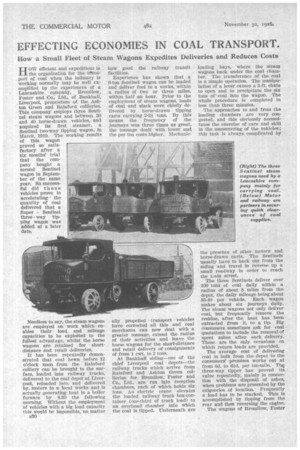EFFECTING ECONOMIES IN COAL TRANSPORT.
Page 56

Page 57

If you've noticed an error in this article please click here to report it so we can fix it.
Row a Small Fleet of Steam Wagons Expedites Deliveries and Reduces Costs
HOW efficient and expeditious is the organization for the tfansport of coal when the industry is working normally may be well exemplified by the experiences of a Lancashire company, Bromilow, Foster and Co., Ltd.-, of Bankhall, Liverpool, proprietors of the, Ashton Green .and Rainford collieries. This company employs three Sentinel steam wagons and between 30 and 40 horse-drawn vehicles, and acquired Its first steamer, a Sentinel two-way tipping wagon, in March, 1919. The working -results of this wagon
proved so satisfactory after a six months' trial that the company bought a second Sentinel wagon in September of the same year. So successful did these vehicles prove in accelerating ' the quantity of coal delivered that a "Super Sentinel three way tipping wagon was added at a later date.
Needless to say, the steam wagons are employed on work which enables their load and mileage capacities to be exploited to the fullest advantage, whilst the horse wagons are retained for shortdistance and retail deliveries.
It has been repeatedly demonstrated that coal hewn before 12 o'clock noon from the Rainford colliery can be brought to the surface, loaded into railway trucks, delivered to the coal depot at Liverpool, reloaded into, and delivered by, motors to a local works and is actually generating heat in a boiler furnace by 8.30 the following morning. Without the employment of vehicles with a big load capacity this would be impossible, no matter
B0 how good the railway transit facilities.
Experience has shown that a 6-ton Sentinel wagon can be loaded and deliver fuel to a works, within a radius of two or three miles, within half an hour. Prior to the employment of steam wagons, loads of coal and slack were chiefly delivered by horse-drawn tipping carts carrying 2-2i tons. By this means the frequency of the journeys was three times as great, the tonnage dealt with lower and the per ton costs higher. Mechanic ally propelled transport vehicles have corrected all this and coal merchants can now deal with a greater tonnage, extend the radius of their activities and leave the horse wagons for the short-distance and retail delivery of consignments of from 1 cwt. to 2 tons.
At Bankhall siding—one of the chief Liverpool coal depots—the railway trucks which arrive from Rainford and Ashton Green collieries for Bromilow, Foster and Co., Ltd., are run into reception chambers, each of which holds six tons. An electric crane elevates the loaded railway truck box-container (one-third of truck load) to an overhead chamber into which the coal is tipped. Underneath are loading bays, where the steam wagons back under the coal chamber. The transference of the coal is a simple operation. The 'manipulation of a lever causes a 3-ft. chute to open and to precipitate the six tons of coal into the wagon. The whole procedure is completed in less than three minutes.
The approaches to and from the loading chambers are very congested, and this obviously necessitates the exercise of care and skill in the manceuvring of the vehicles; this task is always complicated by the presence of other motors and horse-drawn carts. The Sentinels usually have to back out from the siding and travel in reverse up a small roadway in order to reach the main street The three Sentinels deliver over 100 tons of coal daily within a radius of about 8 miles from the depot, the daily mileage being about 35-40 per vehicle. Each wagon makes about six journeys daily. The steam wagons not only deliver coal, but frequently remove the residue, after the heat has been extracted from it, to a tip. Big consumers sometimes ask for coal quotations to include the removal of spent ashes after each delivery. These are the only occasions on which return loads are provided.
The average cost of delivering coal in bulk from the depot to the consumers' premises works out at from dd. to 61d. per ton-mile. Tb.c. three-way tipper has proved its value repeatedly, mainly in connection with the disposal of ashes, when problems are presented by the exigencies of location. Frequently a load has to be stacked. This is accomplished by tipping from the rear and then reversing the engine.
The wagons of Bromilow, Foster and Co., Ltd., also cart bricks from • brickworks at Rainford to housing sites at Liverpool.
Comparisons og transport costs in the conveyance of bricks from • Rainford to Liverpool (a) by rail . and (b) by steam wagon show a decided advantage in favour of the latter. The railway quotation for
• the carriage (not including labour costs for loading and unloading) of .6,000 bricks from Rainford to Gateacre', Station, Liverpool, about 9i miles, is 3s. 9d. per ton. Each cubic foot of brick weighs about 120 lb. and 6,000 bricks would represent about 24 tons. Therefore, the actual cost of rail transit would be -about £4 lOs.. To this must be added 7s. per 1,000 bricks for cartage, making a total of £.6 12s.
The Super-Sentinel wagons can carry about 2,000 bricks per journey. The all-in cost of transport by motor between the two extreme points—the brickworks and the Liverpool housing site—works out at a pproxim ately 14 10s.




















































































































